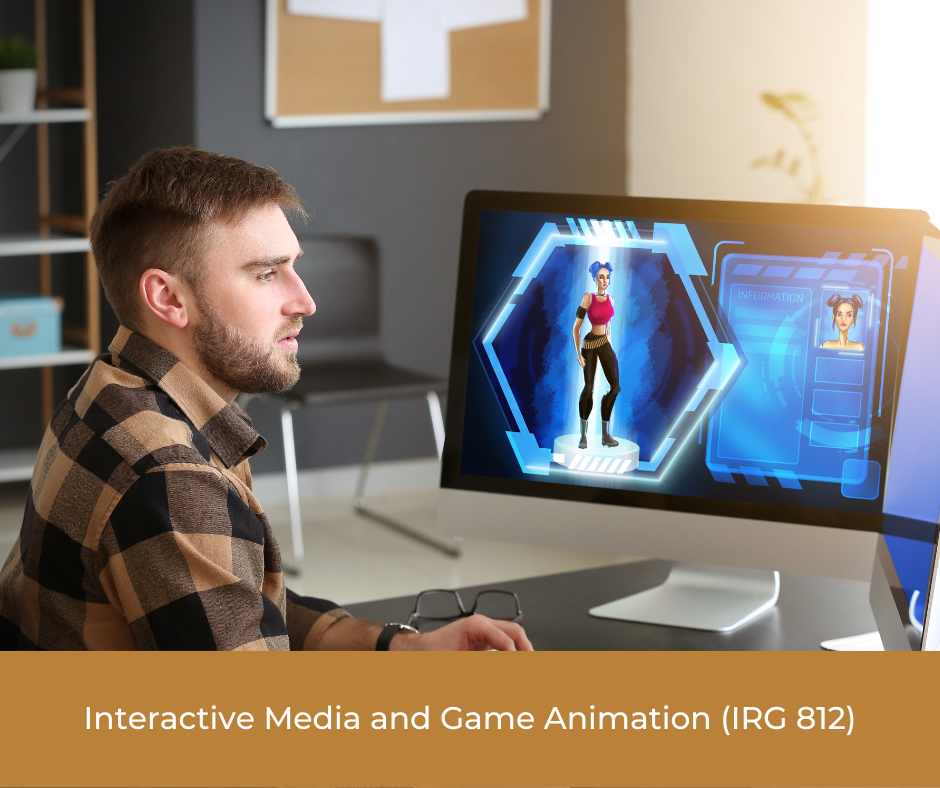Course Description: The Interactive Media and Game Animation course is an advanced exploration of animation tailored for interactive media, with a primary focus on video games and virtual reality. Students will delve into real-time animation techniques, interactive storytelling, and character design specific to the gaming industry. This course equips students with the skills and knowledge required to create compelling animations and interactive narratives for games and virtual reality experiences.
Outline of Major Content Areas:
- Real-time Game Animation:
- The principles of real-time animation, with a focus on the gaming environment.
- Techniques for optimizing animations for smooth, responsive in-game performance.
- The role of animation in enhancing the player’s gaming experience.
- Game Engine Integration:
- Integration of animations into popular game engines, such as Unity and Unreal Engine.
- Real-time rendering and scripting to achieve dynamic and interactive animation sequences.
- Navigating the tools and capabilities of game engines for animation.
- Interactive Storytelling in Games:
- The art of interactive storytelling, branching narratives, and player choices.
- Creating compelling narratives and character-driven experiences within the game medium.
- Exploring the role of animation in enhancing interactivity and immersion.
- Character Design and Development for Games:
- Design principles for creating memorable and functional game characters.
- Character modeling, texturing, and rigging for in-game animation.
- Development of character-driven animations and emotions.
- Practical Projects:
- Students will embark on a series of practical projects, including the creation of game animations, interactive narratives, and character designs suited for real-world gaming applications.
- Emphasis will be placed on developing animations and assets that are ready for integration into game engines and virtual reality environments.
Course Learning Outcomes:
Upon successful completion of this course, students will be able to:
- Real-time Game Animation Competence:
- Develop animations that are optimized for real-time rendering within game environments.
- Understand the technical and creative aspects of real-time game animation.
- Game Engine Proficiency:
- Integrate animations effectively into popular game engines like Unity and Unreal Engine.
- Implement scripts and real-time rendering to create interactive animations within game environments.
- Interactive Storytelling Mastery:
- Create immersive, character-driven narratives that adapt to player choices.
- Apply animation to enhance interactivity and storytelling in the context of games.
- Character Design and Development Skills:
- Design, model, texture, and rig characters for gaming applications.
- Develop character animations that convey emotions and enrich the gaming experience.
- Practical Application:
- Produce game animations, interactive narratives, and character designs suitable for integration into real-world gaming projects.
- Demonstrate a comprehensive understanding of animation techniques, game engine integration, and character design for games.
Methods for Assessing Student Learning:
Assessment in this course will involve various methods designed to evaluate students’ understanding and practical skills:
- Game Animation Projects: Students will complete a series of game animation projects, demonstrating their ability to create animations suitable for real-time gaming environments. These projects will be assessed for technical proficiency, creativity, and interactivity.
- Game Engine Integration: Evaluation of students’ ability to integrate animations into popular game engines, including Unity or Unreal Engine, while ensuring smooth real-time performance.
- Interactive Storytelling Projects: Students will develop interactive narratives or game scenarios that showcase their understanding of character-driven storytelling and player choices. These projects will be assessed for narrative quality and the effective use of animation.
- Character Design and Development: Assessment of students’ character designs, models, and animations for games. This will include evaluating the creativity, functionality, and visual appeal of in-game characters.
- Final Project Assessment: The culmination of this course will involve the assessment of a final project that integrates all aspects of interactive media and game animation. This project should demonstrate a holistic understanding of real-time animation, game engine integration, interactive storytelling, and character design.
By successfully completing this course, students will gain the expertise necessary to excel in the field of interactive media and game animation, allowing them to contribute to the creation of engaging and immersive gaming experiences and virtual reality applications.
